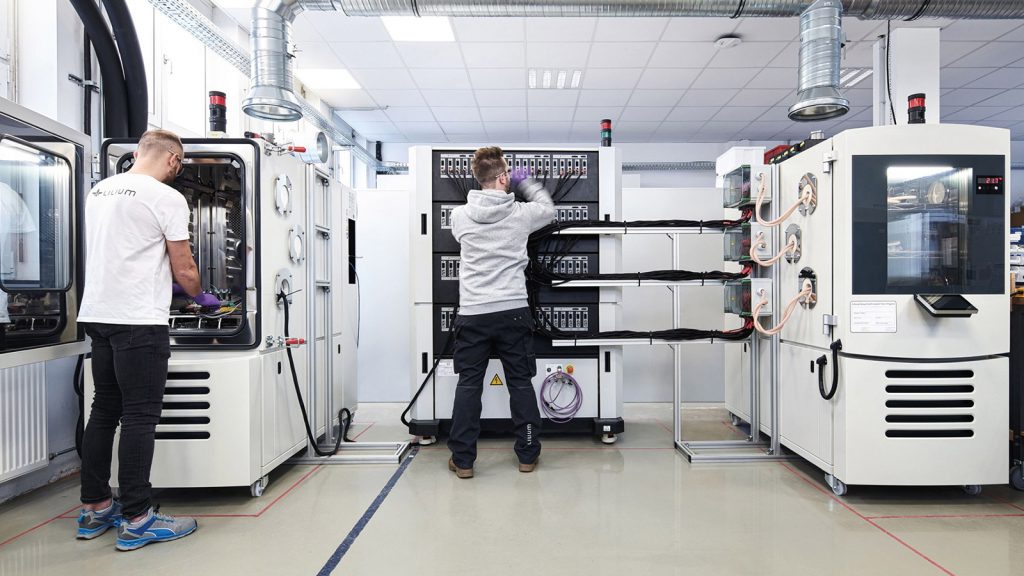Better Batteries by Design
A look at how battery technology is advancing to deliver the performance attributes required by eVTOL aircraft
‘Fast’, ‘quiet’, ‘convenient’. Three virtues that manufacturers of all-electric, vertical take-off and landing (eVTOL) aircraft cite as advantages over traditional ride-sharing options such as Uber, Lyft, the India-based Ola and China’s Didi. For example, Joby Aviation expects to deliver journeys that are up to 10 times faster than driving with its electric taxi, which is designed to carry a pilot and a maximum of four passengers at speeds of up to 200mph.
Quantifying how much potential there is for eVTOLs is difficult. Analyst forecasts differ widely, but Joby is betting that the global market will be ‘large’. However, it concedes that the market remains undeveloped and there is no guarantee of future demand.
Such uncertainties have led to a scarcity of investment from which many manufacturers have been left bruised and battered. Notably, Germany’s Volocopter and Lilium find themselves in insolvency proceedings as they seek an injection of finance and restructuring, although Lilium has announced an asset purchase agreement with Mobile Uplift Corp, a company set up by a consortium of investors from Europe and North America. The deal was expected to close in January ahead of a business re-start, but no further details have been released.
eVTOL success is also largely dependent upon the utilisation rate of the aircraft – the amount of time the aircraft spends in the air carrying passengers or cargo. High daily aircraft utilisation is achieved in part by reducing turnaround times at skyports and by having the right battery technology.
Speaking in 2023, Daniel Wiegand, co-founder and Chief Engineer for Innovation & Future Programs and Executive Director at Lilium, said he believed from a technology point of view that by 2050, around 50% of all flown passenger kilometres could be done in a battery electric aircraft. In addition, over the next ten-20 years, he expected 75% of electric aircraft performance improvements to come from the battery.
Fast forward two years, and comments from Bruno Even, CEO of Airbus Helicopters, seems to have poured cold water on such optimism. Speaking to journalists during a media briefing at the end of January 2025, Even confirmed the company is pausing the development of its CityAirbus NextGen eVTOL aircraft. The reason? Concerns over the maturity of battery technology, which the company doesn’t feel reliably meet the requirements for range, performance and cost-effectiveness currently.
“The launch of a new program depends on many factors, the maturity of the business model, and the maturity of the technology … some of them need to evolve in order to be in a position to launch a new program,” he said.
CityAibus NextGEn was designed to transport up to four people – three passengers and a pilot – over 80km, with a cruising speed of around 120kmph.
Could do better
A sanguine Tine Tomažič, Director of Engineering & Programs at Pipistrel admits that “When we consider the battery challenges facing eVTOLs, we recognise that battery technology must continue to evolve to increase performance as well as developments with charging and charging stations.”
Nonetheless, he deems that, “We are witnessing progress, as this is ever evolving as we continue to learn, develop and innovate.”
Pipistrel is behind the Nuuva V300 – a long-range, large-capacity hybrid-electric VTOL unmanned aircraft – successfully completed its first flight on 31 January 2025. Equipped with a zero-emission electric vertical take-off powertrain and a separate dedicated cruise propulsion system, Tomažič says the Nuuva V300 will provide unparalleled flexibility and runway independence. The aircraft is powered by in-house developed proprietary battery systems, ensuring efficient, sustainable and cost-effective performance. This unique combination of technologies will enable the Nuuva V300 to operate in a wide range of environments.
Researchers at Oak Ridge National Laboratory (ORNL) are one team that is pushing our understanding of eVTOL battery performance. Led by Illias Belharouak, an ORNL Corporate Fellow, the researchers have concluded that eVTOL batteries can’t just be adapted from electric car batteries, which they claim has been the dominant approach to the technology.
The conclusion and other takeaways are the results of efforts from early 2024, which saw Belharouak and his team evaluating how lithium-ion batteries fare under extremely high-power draw, linking actual flight profiles to real-time physical battery operation.
Under the now-closed programme, lithium-ion batteries were created by the ORNL team at the DOE Battery Manufacturing Facility located at ORNL and run through simulated climb stages of eVTOL aircrafts. What happened inside the battery during cycling, including how much energy was rapidly accessible during the demanding take-off phase, was studied, while afterward, the battery materials were tested for corrosion and other chemical or structural changes.
One of the immediate findings was that the power and performance demands for eVTOL batteries can significantly reduce their longevity and durability.
Unlike electric vehicle batteries, which typically drain at a steady rate, there is a significant difference in eVTOL power requirements between take-off and cruise flight in. Take-off requires a high burst of power, while cruise flight operates at a medium-to-low power level relative to the take-off phase. Similarly, landing also demands high power, and the vehicle often transitions directly into charging mode, meaning the battery never gets a chance to rest electrically or thermally.
Another limitation is cycle life. eVTOLs are used in urban air transportation, where they will need to be recharged multiple times a day. Therefore, eVTOL batteries must be able to withstand multiple charge/discharge cycles and maintain a certain SOC (State of Charge).
“Now we know more about what is required of the eVTOL battery, we’ll need to engineer systems differently to achieve that,” said ORNL lead researcher Marm Dixit. “Our focus is fundamental: What happens to the materials under these specific loads and operating conditions? We are trying to figure out the limitations of the battery chemistry we have now and then tune the battery to bridge that gap.”
As part of the study, the ORNL researchers developed a new electrolyte and tested it against the current state-of-the art version used in lithium-ion batteries. As the ORNL explained, using the eVTOL mission profiles, its electrolyte performed better, retaining more capacity during the most power-demanding flight phases, calling into question the current measurement of battery performance.
As Dixit testifies, “Your battery is not just capacity at the end of 1,000 cycles. It’s what’s happening within a cycle that tells you whether your system is going to work or crash. And the stakes are much higher here because you’re asking how safe it is to go up in the air. This is a question we don’t know the answer to — yet.”
Designing for density
For Pei Feng, President of Greater Bay Technology (GBT), the battery system is the ‘base station’ in the clean energy network, and its speed of energy flow affects the efficiency of industrial innovation and user experience.
GBT Battery entered the eVOTL field for the first time in 2024 when it entered into a strategic cooperation with Ehang Intelligence to jointly develop the world’s first eVTOL eXtreme fast charging battery solution for low-altitude aircraft for short-distance flights and frequent take-offs and landings.
Battery cell technology, as Tomažič told Aerospace Innovations, is constantly evolving. “The current state of battery cell technology for eVTOLs involves a complex balancing act between several critical factors: energy density, power output, battery lifetime and cost.”
For its part, GBT characterises current traction battery technology in terms of performance improvement, technological innovation and industrial intelligence.
As a company spokesperson expounded, performance enhancement is mainly reflected in the energy density which continues to climb. They asserted that at present, the energy density of lithium-ion batteries has been raised from the initial 100Wh/kg to more than 200Wh/kg, about 3-5 times that of lead-acid batteries. This means that in the same volume or weight, lithium-ion batteries are able to store more energy, which significantly improves the range of new energy vehicles and meets consumer demand for long range. In the field of cutting-edge solid-state battery technology, this indicator has reached 400wh/kg, and the energy density improvement has a greater effect on alleviating mileage anxiety. This is due to high fault tolerance of the solid state’s positive and negative electrode materials.
EHang has a strategic investment in Shenzhen Inx Technology Co., Ltd. (Inx), a solid-state lithium metal battery technology company in China. Inx’s solid-state lithium metal battery differs from existing traditional lithium-ion batteries by using lithium metal instead of graphite as the negative electrode and solid-state electrolyte instead of liquid electrolyte separators.
Dr. Lin Chen, Chairman and Head of Research & Development of Inx, has stated that after over a decade experience of dedicated research and technological development, Inx’s solid-state lithium metal batteries have an energy density of 450Wh/kg based on 6Ah-50Ah cells. Equipped with this solid-state battery, EH216-S has already completed a continuous 48 minutes and 10 seconds flight test, which is applicable to different flight requirements and significantly improves the flight endurance by 60%-90%.
A method of realising high energy density, is through optimising the battery structure design. “By optimising the structural design of the battery, the space utilisation of the battery can be improved, so as to enhance the energy density,” the GBT spokesperson states.
GBT has made the battery cell, module and system board a lightweight design.
“For the battery cell, under the premise of meeting the performance of eXtreme fast charging [Compared with the existing aircraft batteries, GBT claims the eXtreme fast charging battery system for low-altitude aircraft released this time has ≥25% increase in energy density, 35% increase in battery capacity, ≥2,000 cycles, and 30% – 80% charging in 5 to 10 minutes], we chose high-capacity anode and cathode materials, increased the proportion of active substances in the pole piece, and reduced the quality of auxiliary materials in the battery cell, so that the battery cell has the energy density that is not inferior to the conventional ternary cells,” the spokesperson said.
In terms of the module, GBT has adopted an integrated large module design, with more than 60 pieces of battery cells integrated in a single module, and adopted the platformised structure design, using the ultra-thin shell to integrate the module. The lower shell uses aluminium extrusion and stamping brazing and an integrated liquid cooling plate structure, which saves space in the Z-direction and reduces weight. The upper case adopts an MSC high-tech composite material top cover, which ensures mechanical strength while the density is only 1.3~2.0g/cm³.
According to Pipistrel’s Tomažič, every project the company engages in employs a custom battery architecture, which intrinsically optimises different parameters, including size, weight, power, cost, cycle life, shelf life, environmental durability, serviceability, various degrees of system redundancy, and power distribution.
Whatever the approach, there is a need to increase energy density without increasing battery size, and to minimise battery weight, as the weight of an airplane directly affects its flight performance and safety, and an overweight battery increases energy consumption and reduces range and flight efficiency. Additionally, a reasonable battery layout can optimise the aircraft’s centre of gravity distribution and improve flight stability and safety.
Overcoming cell degradation
The degradation of traction batteries has always been a key factor limiting their performance and life. In recent years, battery technology has made significant progress in material chemistry, providing a variety of solutions to solve this problem. Through the efforts of electrolyte optimisation, cathode and anode material improvement, battery structure design optimisation and battery management system application, the degradation problem of traction battery is gradually being solved.
Pipistrel is balancing and managing performance metrics with the needs of the operator by simplifying any complex battery details for operators, who receive easy-to-understand information. This includes State of Charge (SoC) which shows the battery’s current charge level as a percentage; State of Health (SoH) which indicates the battery’s condition and how much it has aged; and Operating Temperatures which provides real-time temperature data to ensure safe operation.
“This user-friendly approach helps operators manage the battery efficiently and safely. We’ve successfully implemented this with the Velis Electro, and operators have found it very useful,” says Tomažič.
The company is also addressing cell degradation through multiple approaches. As Tomažič explains, they are exploring advanced chemistries, including silicon-anode and solid-state lithium technologies, through various research programs. They are also optimising the integration of batteries into the aircraft structure, including the development of structural batteries, as well as enhancing thermodynamic efficiency with liquid and hybrid cooling systems to better manage battery temperatures.
“Additionally, we conduct extensive testing to identify optimal operating conditions, temperature ranges, power loads, and charging cycles that can slow down degradation for each cell type. There is no one-size-fits-all solution, as different chemistries require tailored approaches,” he asserts.
Safe discharge
While designed to maximise reliability, such battery systems must also endure aggressive duty cycles with discharge demands of up to 6C, putting great pressure on their design. Additionally, these batteries must operate under challenging environmental conditions, such as temperature extremes, vibration, and mechanical shock experienced during landings.
At Pipistrel, safety has been a top priority throughout its journey of lithium battery development, which began over 15 years ago with commercial off-the-shelf (COTS) cells. “We have consistently adhered to the highest safety standards during our research and development processes.
“Our batteries are designed to meet rigorous safety criteria, ensuring that our products are reliable and meet highest performance standards,” confirms Tomažič.
In order to satisfy the safety requirements of aviation batteries, GBT has designed a dual-branch system for the battery pack, added a closed backup system isolated from the main system, and designed a dual-branch system for the battery pack, in the event of a failure of the primary system, there are still two backup systems that can continue to work instead of the primary system to ensure the safety of the vehicle. Space-grade nano-insulation material is used between the main system and the backup system to realise effective fire prevention and heat insulation.
In order to promote the commercialisation and popularisation of eVTOL batteries, in 2023, GBT opened its 189,000m2 specialised factory for eXtreme fast charging traction battery in Nansha, Guangzhou. The factory includes cell production workshop, battery safety experiment workshop, test workshop, pilot plant, PACK workshop capabilities amongst other activities.
That same year, Vertical Aerospace opened its Vertical Energy Centre (VEC), believed to be the UK’s most advanced aerospace battery facility, based in Bristol. The 15,000ft2 facility, is one of the only dedicated aerospace battery facilities in the UK, and home to Vertical’s battery team which is developing proprietary battery technology combined with cell technology from its strategic partner, Molicel.
The first in-house developed prototype battery modules have already been assembled in the facility which gas also seen the battery systems undergo a wide range of testing, including temperature, conducted emissions, vibration, thermal durability and characterisation, propagation and drop testing at the VEC. Vertical has previously had significant progress with battery tests, having carried out crash and thermal runaway testing under European Union Aviation Safety Agency and the UK’s Civil Aviation Authority supervision.
According to the company, it has developed significant intellectual property around battery design including cell packaging, cooling and electronic battery management systems to deliver high-power, high-performance battery packs capable of powering eVTOL aircraft. Vertical is aiming for entry into service with a 220Wh/kg battery system. This will enable Vertical’s VX4 eVTOL to conduct back-to-back missions, with fast-charging cycles in-between, and minimised impact on the packs’ cycle life.
A second chance
Extending the serviceable life of the battery is one thing, but what of repurposing these batteries after their eVTOL service. The teams at Pipistrel and EHang among others, are exploring second-life batteries.
The common ways to reuse eVTOL batteries are recycling, after station utilisation, technology upgrading and reuse.
Professional battery recycling organisations or those companies with advanced battery dismantling technology and environmentally friendly equipment can safely and efficiently recycle valuable materials in the batteries, such as lithium, cobalt, nickel etc. The recovered metal materials can be used to produce new batteries, reducing the need for new raw materials, but also reducing production costs and environmental pollution.
GBT says another opportunity is the use of eVTOL batteries in energy storage systems, such as home energy storage, industrial energy storage or grid energy storage, or even in other non-mobile devices, such as streetlights and signal base stations. These devices have relatively low energy density and power requirements for batteries, so the performance of eVTOL batteries can be fully utilised, the spokesperson said.
There may be consensus on the approach to repurposing still-functional components, but opinions are split on whether the relevant legislation is aligned with the realities of eVTOL battery technology.
“Current legislation regarding eVTOL batteries does not need to be reframed to take into account advances in the eVTOL market,” believes Tomažič. “The regulatory landscape is becoming increasingly clear, and from an infrastructure standpoint, an eVTOL should be capable of landing at any vertiport, airport, or heliport. We are closely monitoring the standardisation of charging infrastructure to ensure compatibility and safety.”
A different perspective comes from China. “Legislation on eVTOL batteries can no longer adapt to the rapid development of eVTOL battery technology. For example, the existing battery safety standards, performance test methods, and airworthiness validation processes cannot adequately cover the special requirements of eVTOL batteries,” says the GBT spokesperson. “In addition, with the continuous innovation of battery technology, new battery materials and structures may bring new safety risks, which also require timely assessment and updating by the legislative bodies.”
By Alexander Preston




